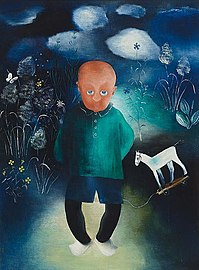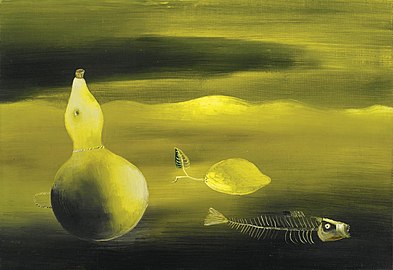Tinus van Doorn
Tinus van Doorn , actually Martinus Jacob van Doorn (born June 2, 1905 in Padang , Dutch East Indies , † May 17, 1940 in Ukkel , Belgium ), was a Dutch expressionist painter, draftsman and graphic artist .
Life
When Tinus van Doorn was eight years old, his family returned from Sumatra to the Netherlands and settled in The Hague , where he attended the Hogereburgerschool . During this time he made many woodcuts. In 1924 he began studying at the Koninklijke Academie van Beeldende Kunsten in The Hague, which he did not finish. In 1928 he lived in Oegstgeest and a year later settled in Rotterdam , where in 1929 he married the 15 years older pianist Annie "Akkie" Vermeulen. In 1931 he was awarded the Willink van Collenprijs by the Amsterdam artists' association Arti et Amicitiae , of which he was also a member. Several museums bought his work; In 1933 he had his first major solo exhibition in the Stedelijk Museum in Amsterdam . He also illustrated literary works, including by Jan Jacob Slauerhoff , Albert Helman , Antoon Coolen and Martinus Nijhoff .
In 1933 Van Doorn and his wife moved to the Achterhoek on the German border. He watched the rise of National Socialism in Germany with concern . After traveling through Spain and Portugal, he moved to Belgium with his wife in 1938 and settled in Uccle, a suburb of Brussels . There he was a neighbor of the Belgian poet Jan van Nijlen , whose poems he used for a small edition of woodcuts. Although he worked hard, he increasingly lost faith in himself. He was so affected by the outbreak of World War II that he made a series of "anti-war drawings". On May 17, 1940, the day the Germans occupied Brussels, Tinus van Doorn and his wife jointly committed suicide .
plant
Van Doorn was constantly experimenting with shape and color. His works were influenced by the expressionists Franz Marc and Marc Chagall as well as by Cubism and naive art. They presented different themes: animals, Arcadian landscapes, biblical scenes, farmers, tramps, fair and circus performances and people on the fringes of society. Van Nijlen characterized the work of van Doorn as "extremely simple, sometimes almost childlike". The reviewer Annemiek Buijs wrote in 2018 that his pictures radiated “the desire for heavenly joy and outdoor life”. After 1933 his work became darker, the people and animals in his pictures "resist a dark force that swallows the light".
Tinus van Doorn's work includes around 150 paintings, 400 drawings, linocuts, 15 sculptures, stage sets and illustrations for novels, poetry collections and children's books. His works are in the collections of the Stedelijk Museum in Amsterdam, Lakenhal in Leiden , Museum Belvedere in Heerenveen , Museum Boijmans Van Beuningen in Rotterdam , Gemeentemuseum Den Haag and Van Abbemuseum in Eindhoven .
gallery
literature
- Doorn, Tinus van . In: General Artist Lexicon . The visual artists of all times and peoples (AKL). Volume 29, Saur, Munich a. a. 2001, ISBN 3-598-22769-8 , p. 22.
- Erik Slagter et al .: Tinus van Doorn, 1905–1940. Kunstenaar van het lost paradijs. Catalogus Lakenhal, Leiden 2005, ISBN 978-90-809056-5-8 .
- Pieter A. Scheen: Lexicon Nederlandse beeldende kustenaaren, 1969–1970. Vol. 1, pp. 274-275.
- PMJ Jacobs: Beeldend Nederland: biographical handbook: Tilburg: Stichting Studiencentrum voor beeldende kunst, 1993: ISBN 90-801063-1-3
Web links
- Tinus van Doorn on artnet
- Biography of Tinus van Doorn
- Biography of Tinus van Doorn
- Tinus van Doorn's sketchbook 1916
- Woodcuts by Tinus van Doorn in the Stedelijk Museum Amsterdam
Individual evidence
- ↑ a b Ontdek beeldhouwer, etser, graficus Tinus van Doorn. In: Rijksbureau voor Kunsthistorische Documentatie . Retrieved November 23, 2018 (Dutch).
- ^ Stefan van den Bossche: Jan van Nijlen. Lannoo Uitgeverij, 2005, ISBN 978-9-077-44101-5 , p. 590 ( limited preview in Google book search).
- ↑ a b Benno Tutein Nolthenius: Tinus van Doorn (1905-1940). In: galeries.nl. Retrieved November 22, 2018 (Dutch).
- ↑ Paradise Lost - Recensie: Tinus van Doorn. Signs of the lost paradise. In: 8weekly.nl. November 1, 2005, accessed November 23, 2018 (Dutch).
- ↑ Annemiek Buijs: Erik Slagter - Tinus Van Doorn: kunstenaar van het lost paradijs. In: bol.com. November 16, 2018, accessed November 22, 2018 (Dutch, review).
| personal data | |
|---|---|
| SURNAME | Doorn, Tinus van |
| ALTERNATIVE NAMES | Doorn, Martinus Jacob van (baptismal name) |
| BRIEF DESCRIPTION | Dutch painter, draftsman and printmaker |
| DATE OF BIRTH | June 2, 1905 |
| PLACE OF BIRTH | Padang , Sumatra |
| DATE OF DEATH | May 17, 1940 |
| Place of death | Ukkel , Belgium |












